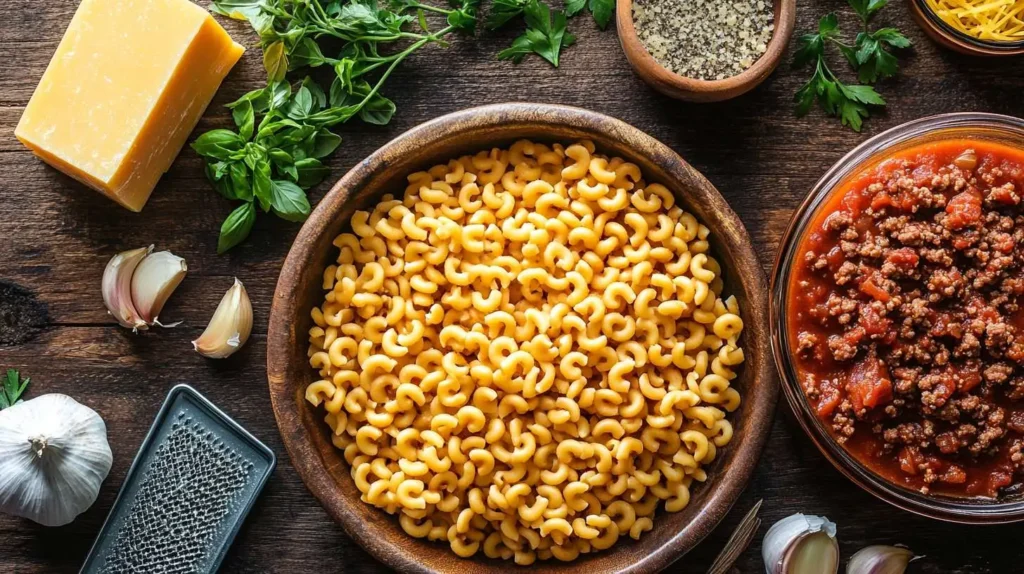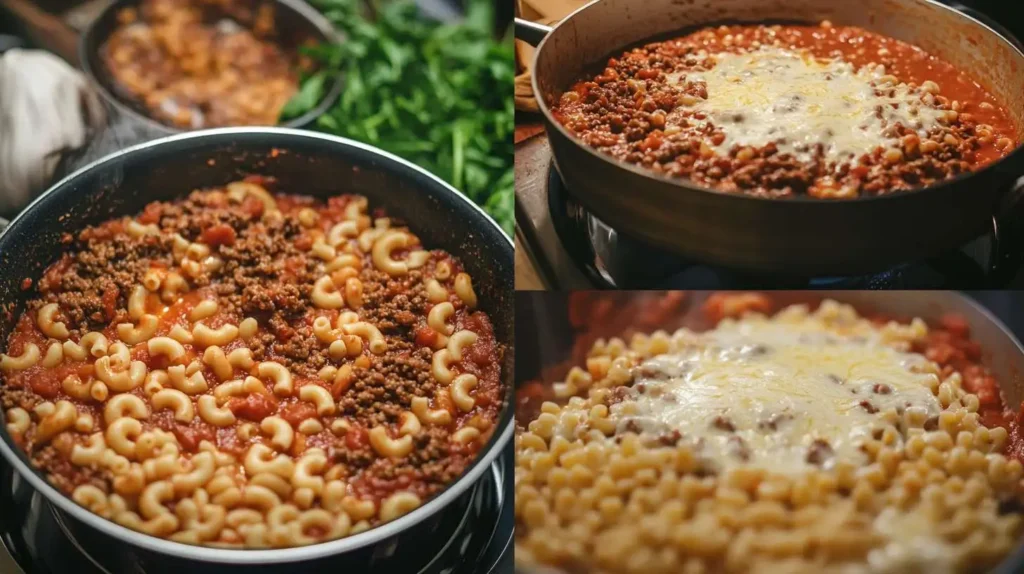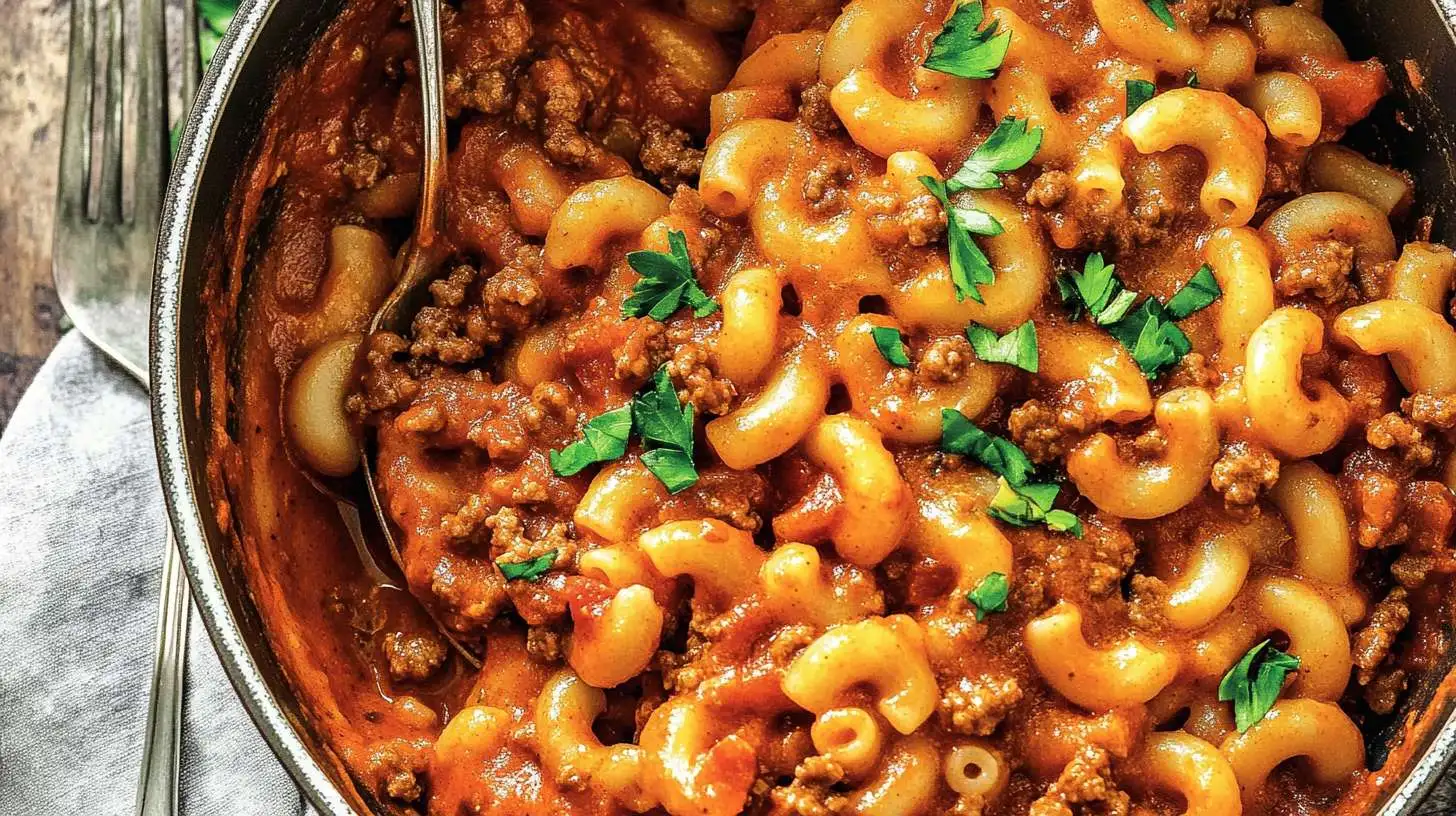Beefaroni often flies under the radar when people talk about classic comfort foods, but if you’ve ever tried it, you know it deserves a spotlight. This iconic pasta-and-beef blend is perfect for those who crave warm, hearty meals without spending hours in the kitchen. Plus, it offers a simple way to gather your family around the table, sharing laughs and big bowls of a timeless favorite. Whether you’re completely new to this dish or you remember it fondly from childhood, get ready to discover the secrets of a perfect Beefaroni recipe that always delights.
Table of contents
Key Ingredients for the Best Beefaroni Recipe
It’s easy to assume any pasta, sauce, or ground beef will do. But if you want your Beefaroni recipe to shine, each ingredient matters. When everything comes together in perfect harmony, you’ll have a dish that’s not just tasty—it’ll be downright irresistible. Below, you’ll find the essential components that’ll elevate your recipe to new heights.

Choosing the Ideal Pasta Shape
Ever wonder why elbow macaroni shows up so often in Beefaroni? It’s small, easy to eat, and scoops up sauce beautifully. But that doesn’t mean you can’t experiment. If you’ve got other short pasta shapes in your pantry, give them a try.
- Elbow Macaroni: Classic shape for timeless Beefaroni, perfect for soaking up every bit of sauce.
- Shells or Rotini: Great for holding onto sauce in their crevices—ideal if you like a thicker blend.
- Penne: More tubular and sturdy, giving your dish a modern twist while maintaining that comforting feel.
Think about the experience you want. Do you like a pasta that soaks in the sauce until it’s practically part of each noodle? Or do you want a bit of chewy contrast? A great pasta shape can make each bite a delight.
Selecting High-Quality Ground Beef
Ground beef is at the heart of Beefaroni. If the beef tastes bland or comes out dry, the whole dish can fall flat. Choosing the right type makes a huge difference.
- Lean Ground Beef (85/15 or 90/10): This balance offers flavor without drowning your dish in grease.
- Grass-Fed Beef: Known for a richer, more nuanced taste, though it can be pricier.
- Fresh is Best: If possible, buy from a butcher or a reliable grocery store to ensure quality.
Cooking up fresh, high-quality beef helps prevent that dreaded rubbery texture. Plus, it means every mouthful bursts with savory goodness.
Which Sauce Works Best? Tomato, Marinara, or Homemade?
The sauce in Beefaroni recipe can lean tangy, sweet, or even spicy, depending on your preference. Don’t be afraid to explore different flavors to see which one makes your taste buds the happiest.
- Plain Tomato Sauce: Offers a blank canvas for spices and herbs.
- Marinara Sauce: Gives a more seasoned, Italian-style flavor with onions, garlic, and herbs.
- Homemade Sauce: Lets you control every element, from sugar level to spice blend.
No matter your choice, remember to taste as you go. A spoonful here and there helps you fine-tune the balance until it’s just right.
Must-Have Seasonings and Flavor Boosters
Seasonings bring your Beefaroni’s taste to life. While salt and pepper are non-negotiable, there are a few other flavor superheroes to keep handy.
- Onion and Garlic: Aromatic staples that lay a tasty foundation.
- Herbs (Basil, Oregano, Thyme): The key to injecting your sauce with that comforting, home-cooked vibe.
- Cheese (Parmesan or Cheddar): Adds richness and that gooey factor people can’t resist.
Experiment with extra seasonings if you’re feeling adventurous. A dash of chili flakes can turn up the heat, and a spoonful of sugar can help balance out tart tomatoes. When in doubt, keep it simple. After all, some of the best meals rely on just a few top-notch ingredients.
Step-by-Step Cooking Instructions for a Beefaroni Recipe
Ready to transform simple ingredients into a comforting bowl of Beefaroni recipe? The following steps guide you from start to finish. Don’t worry if you’re new to cooking—this dish is beginner-friendly yet satisfying enough for seasoned chefs.

Prepping Your Kitchen and Ingredients
Before you fire up the stove, gather everything you need. This approach helps you move through each step quickly and reduces last-minute scramble.
- Check Your Pantry: Make sure you have pasta, ground beef, and sauce.
- Measure Your Spices: Having salt, pepper, and herbs pre-measured can save time.
- Chop Veggies: If you’re adding onions, bell peppers, or garlic, dice them beforehand.
Tip: Lay out all utensils (like spatulas, ladles, and pots) within arm’s reach. You’ll feel like a pro in your own kitchen.
Boiling the Pasta: Timing and Tips
Cooking pasta might seem straightforward, but timing is everything when it comes to achieving that perfect al dente bite.
- Fill Your Pot: Use a large pot of water, leaving some room at the top to prevent boil-overs.
- Add Salt: A generous pinch goes a long way in boosting flavor.
- Bring to a Rolling Boil: Wait until the water is actively bubbling.
- Add the Pasta: Stir occasionally to keep noodles from sticking.
Tip: Cook pasta about 1–2 minutes shy of the package directions if you’re planning to bake your Beefaroni later. You want to avoid mushy noodles.
Browning the Beef: Getting the Perfect Texture
Your ground beef deserves some love, too. Proper browning makes all the difference between bland crumbles and savory morsels of meaty goodness.
- Heat the Pan: Warm up a skillet or sauté pan over medium-high heat.
- Add a Little Oil: Just enough to lightly coat the bottom of the pan.
- Crumble the Beef: Break it up with a spatula or wooden spoon as it cooks.
- Season as You Go: Sprinkle in salt, pepper, and any other desired herbs.
Tip: Drain off excess fat carefully once the beef is browned. Too much grease can make your sauce heavy and less flavorful.
Combining the Meat and Sauce
Now comes the fun part—watching your dish come together as the browned beef marries your chosen sauce.
- Add Onions or Garlic: If you’re using chopped onions or garlic, toss them in with the beef for an extra flavor boost.
- Pour in the Sauce: Stir gently to coat every piece of beef.
- Simmer: Lower the heat and let the mixture bubble for a few minutes.
- Taste and Adjust: A dash of salt, a pinch of sugar, or extra herbs can tweak the flavor to your liking.
Tip: Stir in a little pasta water if your sauce seems too thick. The starchy water helps bind everything together.
Baking vs. Simmering: Which Method Suits You Best?
You can either serve your Beefaroni straight from the stovetop or opt for a quick bake in the oven. Each method offers its own perks.
- Stovetop Simmer:
- Faster: You can dig in as soon as your pasta and sauce are done.
- Easy Cleanup: Fewer dishes for busy weeknights.
- Great for Adjusting Seasoning: Taste and tweak until it’s perfect.
- Oven-Baking:
- Cheese Heaven: Melt a top layer of cheddar or mozzarella for a golden, bubbly crust.
- Infuses Flavor: Everything warms together, creating a cohesive, savory blend.
- Impressive Presentation: Great for family gatherings or potlucks.
Tip: Want the best of both worlds? Simmer your Beefaroni on the stovetop, then sprinkle cheese on top and pop it under the broiler for a couple of minutes. You’ll get that crispy crust without a lengthy bake.
Common Problems and Practical Solutions
Cooking a Beefaroni recipe can sometimes lead to unexpected hiccups—like soggy noodles or an overwhelming sauce. But don’t worry, a few simple tricks can fix most issues. Below are the most common problems people face and how to solve them with ease.
Avoiding Dry, Overcooked Pasta
Pasta that’s lost its bite can turn your Beefaroni into a mushy mess. Fortunately, you can prevent this by keeping a close eye on cooking times.
- Under-Cook Slightly: Drain the pasta 1–2 minutes before it reaches al dente, especially if you plan to bake it later.
- Rinse with Cold Water: Rinsing helps halt the cooking process if you notice your pasta is approaching that soft, unwanted texture.
- Add a Bit of Sauce: If the noodles look dry right before serving, stir in a touch more sauce or a splash of pasta water to revive moisture.
Eliminating Excess Grease and Oil
No one wants a pool of oil sitting at the bottom of their Beefaroni. Controlling the fat content begins with choosing lean meat and finishes with a proper drain.
- Start Lean: Opt for ground beef labeled 85/15 or 90/10, balancing flavor with less fat.
- Drain Thoroughly: After browning, tilt the pan to let grease pool, then remove the extra fat safely.
- Skim Off the Top: If you see oil gathering while your dish simmers, use a spoon or a paper towel to blot away excess grease.
Enhancing Flavor Without Oversalting
A bland sauce can leave your Beefaroni lacking, but too much salt can turn it into a salty disaster. Striking the right balance is key.
- Taste as You Go: A quick spoonful now and then helps you keep track of how the flavors are developing.
- Use Herbs and Spices: Oregano, basil, garlic powder, and onion powder add robust taste without a salty overload.
- Balance Acidity: If the sauce is too sharp or tangy, stir in a pinch of sugar or a splash of cream to mellow it out.
By mastering these quick fixes, you’ll keep your Beefaroni consistently delicious—creamy, savory, and perfectly cooked every time. If you do stumble upon a hiccup, remember that minor tweaks can make a major difference.
Related Article Recipes You Might Like
If you love classic comfort foods like Beefaroni recipe, you might also enjoy experimenting with different pasta dishes that offer a delicious twist on traditional favorites. For a lighter yet equally satisfying meal, try making Capellini Pasta with Fresh Tomato Sauce its delicate strands soak up flavors beautifully, making it a great alternative when you’re craving a pasta-based dish. If you’re looking for bold, smoky flavors to complement your Beefaroni night, consider adding a side of Chipotle Steak, the rich spice blend and tender meat pair perfectly with hearty, tomato-based pasta.
For another comfort food favorite, try the Million Dollar Chicken Casserole Recipe—a creamy, indulgent dish that will satisfy any crowd. And for a creative way to elevate your pasta game, check out our Fishcakes and Scallops Stir Fry—a seafood dish that brings a fresh and exciting contrast to beef-based meals.
Conclusion and Final Thoughts on the Beefaroni Recipe
Beefaroni recipe stands out as a simple yet satisfying dish that checks all the boxes: it’s comforting, budget-friendly, and flexible enough to accommodate any taste preferences. Whether you choose to amp it up with fresh veggies, experiment with different sauces, or indulge in a cheesy baked topping, there’s always room to make it your own. By selecting quality ingredients and mastering a few core techniques, you’ll serve up a meal that warms both bellies and hearts. Enjoy every flavorful bite!
Frequently Asked Questions About the Beefaroni Recipe
How to Make Beefaroni Better?
Add depth by sautéing onions, garlic, or bell peppers before mixing in the ground beef. A splash of red wine or a spoonful of tomato paste can also enhance flavor. Want more creaminess? Stir in a little heavy cream or cream cheese. Small tweaks like these help elevate a basic Beefaroni into something richer and more memorable.
Is Beefaroni the Same as Goulash?
Not exactly. While they both feature pasta, beef, and a tomato-based sauce, American goulash often includes paprika and sometimes different veggies. Beefaroni typically leans on elbow macaroni, tomato sauce, and ground beef without the same smoky spice profile. They’re similar comfort foods, but the seasoning sets them apart.
What Kind of Cheese for Beefaroni?
Mozzarella and cheddar are popular because they melt nicely, adding gooey richness. Parmesan, meanwhile, delivers a tangy bite. Feel free to mix and match based on taste; you can sprinkle parmesan on top for extra flavor or combine mozzarella and cheddar for a smooth, creamy finish.
How to Spruce Up Beefaroni?
Toss in vegetables like zucchini, mushrooms, or spinach for extra nutrients. Love a kick of spice? Add chili flakes or diced jalapeños. For more flavor complexity, try stirring in fresh herbs like basil or oregano. These small additions bring color, texture, and a fresh twist to your Beefaroni.

